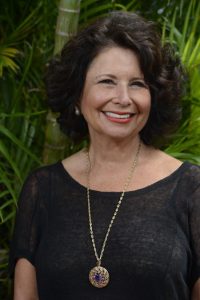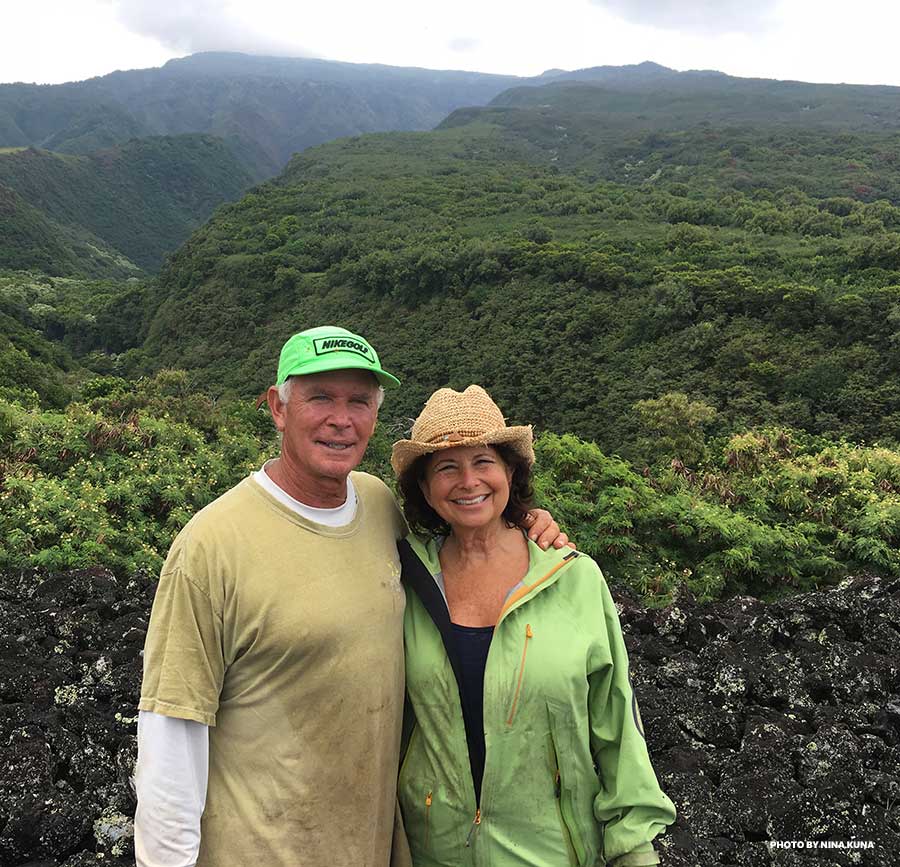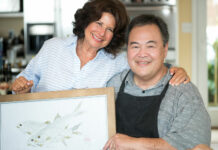By Diane Haynes Woodburn
 This issue of Maui Nō Ka ‘Oi is dedicated to ‘ohana — the Hawaiian word that translates as “family,” but encompasses so much more. ‘Ohana is not just the people we are related to, but those who come into our lives and make a difference.
This issue of Maui Nō Ka ‘Oi is dedicated to ‘ohana — the Hawaiian word that translates as “family,” but encompasses so much more. ‘Ohana is not just the people we are related to, but those who come into our lives and make a difference.
“I understand,” I hear my husband say to someone on the phone. “The important thing is that we do nothing to awaken the pōhaku [rocks].” Awaken rocks?
Jamie is helping our friend Kimokeo Kapahulehua arrange volunteers to clear and clean Lo‘alo‘a Heiau, a Hawaiian temple that time, neglect, and the elements have overtaken. The list of necessities includes chainsaws, weed whackers, machetes, sickles, and a crew of at least thirty. Oh, no, I think to myself, I’m not getting roped into this . . . he’ll never get enough volunteers.”
What changes my mind is learning that Patrick V. Kirch will be there. Dr. Kirch is one of the world’s most respected archeologists, an expert on Polynesia. If he’s willing to have traveled from the mainland to direct this project — then I want to be there too.
The day arrives, and Jamie loads the truck with tools, work gloves, sunscreen and lunch for twenty to fifty workers — we have no idea how many will actually show up. I climb into the cab next to Jamie, and off we go. As we head south and east around the mountain, the vegetation grows sparser. Plains of black lava reach out to a stark and jagged coastline. The road turns from paved to patch, and then to gravel. Finally, we reach Kaupō Store — just as the clouds spill a blessing of rain on the dozen or more volunteers, including Kaupō Ranch representatives waiting to meet us. A short drive into the ranchland, and we arrive at Lo‘alo‘a Heiau.
 “Where is it?” I ask, as I pull on my raincoat. The pleasant sprinkle has gathered force.
“Where is it?” I ask, as I pull on my raincoat. The pleasant sprinkle has gathered force.
“There.” Jamie points to a rubble of rocks and weeds, brush and trees, and an ill-defined rise of more rocks further on. A small sign marks the fenced entrance, the only evidence that something significant lies beyond. We stop to wait for Kahu Lyons Naone. Among kahu’s meanings are “guardian,” “keeper,” and “preacher,” and in all those capacities, Naone has come to ensure that proper protocol is observed. He asks the gods’ permission for us to enter, to mālama (take care of ) the land. We are not to move the stones.
Now it’s Dr. Kirch’s turn. He tells us that Kaupō once comprised the greatest continuous dry-land agricultural area in all the Hawaiian Islands. Its sweet potatoes and dry-land taro fed perhaps 10,000 people. In the early 1700s, King Kekaulike made Kaupō a royal seat and directed construction of Lo‘alo‘a Heiau, one of the largest war temples in the archipelago, and likely used for human sacrifice.
Mindful of what this heiau once represented (and being a rather senior member of the crew), I find a hand sickle and gingerly weed the easier areas of strewn rock — careful not to move any. In the distance, I hear chainsaws growling and weed whackers whirring as Jamie and other men, our sons among them, cut through the jungle of trees and brush engulfing the heiau. More and more people arriving, each eager to contribute to the larger endeavor.
By day’s end, Lo‘alo‘a stands revealed. Dr. Kirch leads us on a tour, carefully climbing to the top of the site, more than 7 meters high and 105 meters long. This spot, he tells us, precisely marks the rising position of the star cluster Pleiades, as well as the direction of the June solstice sunrise. We walk lightly in the footsteps of ancients with quiet respect for the spirit of this place. If these rocks could talk, one might say . . . and perhaps they do.
The view is breathtaking. But I am as moved by the people — more than half a hundred — who have made today possible. We are from all different backgrounds and walks of life. Yet all of us, exhausted and soaked to the bone, understand that in helping to preserve this site for future generations, we have shared something deeply meaningful and satisfying. We are ‘ohana.
A hui hou.




